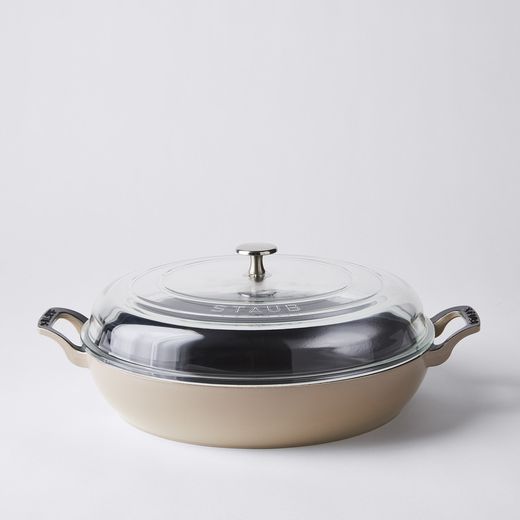Absolute Best Tests
The Absolute Best Way to Cook Shrimp, According to So Many Tests
Never eat an overcooked, rubbery shrimp agan. Never!
Popular on Food52
24 Comments
cosmiccook
June 23, 2024
Living in New Orleans, shrimp are a routine weekly staple. Our default when not using a method for a specific recipe is to steam FLAT. We lay them on either a screen or the slated portion of the broiler (yes it works), sprinkle bay seasoning & garlic powder on them AND in the water along w celery, onion, bay leaves, lemon juice, Crystal (hot sauce). Firm, not overcooked and since they're all one layer, evenly cooked. Keep in mind our shrimp are 12-15 a MOST (head-on) a lb. Boiling just beats them up TOO much & over cooks them.
Liz
June 23, 2024
What a delight to read such a fair well-considered review of methods of cooking shrimp. I'll be snacking on a dozen of them around lunchtime. I want to dip them in drawn butter with lemon. For this method, I'll be boiling the shrimp shell on.
I thank Mother Earth for giving us shrimp They are so delicious, and versatile, and affordable (even for me).
I thank Mother Earth for giving us shrimp They are so delicious, and versatile, and affordable (even for me).
Charlene V.
March 24, 2023
So tired of writers always having to mention their small New York kitchens! Those of us in other cities and states just don’t care! If you want to mention a fact or tip about working in a small kitchen, fine, but there’s no need to preface it with where you live. It’s irrelevant.
Sqsh
February 7, 2023
The part about shrimps vs prawns misses out an important point - the names are different in different parts of the world! So while the statement may be true in the US, here in the UK (and several other countries such as Australia), we call most of them prawns regardless of whether they're fresh or saltwater, while shrimp is a term reserved for very small specimens (such as brown shrimp, often served in the UK as "potted shrimp" preserved in butter).
The classic Australian line "throw another shrimp on the barbie" was actually written specifically for an American audience as the marketers thought "prawn" might confuse them!
The classic Australian line "throw another shrimp on the barbie" was actually written specifically for an American audience as the marketers thought "prawn" might confuse them!
Stephanie L.
January 2, 2022
When I need a simple, boiled shrimp (for shrimp cocktail, for example) I add garlic, lemon and white wine to the water. It adds a lot of flavor and is so much better than plain water.
cosmiccook
June 23, 2024
Yes ALWAYS flavor the water and try steaming flat--the flavor and texture are so superior to boiling.
cosmiccook
December 21, 2021
As a New Orleans native, we steam our shrimp. We eat quite a bit of shrimp 2-3 times a week. Boiling them dilutes the flavor and often overcooks them. We may not have access to many of the wonderful food items as New York and other large metro areas but I can get same day trawled large shrimp (head on no MORE than 12 to a lb.) for $6.00 I feel vindicated. Don't get me started on oysters. Crab once upon a time was inexpensive, but sigh hurricanes & covid changed that.
Liz
June 23, 2024
Crab is the most delicious thing that comes from the ocean. Snow Crab is every bit as good as Maine Lobster.
S M.
December 19, 2021
My fav is to use sous vide. I take the shrimp right out of the freezer and cook. If you buy zipper backed you can easily peel after they are cooked
dapfel
December 19, 2021
I often wonder why recipes call for unsalted butter then also include salt in the recipe. Why not use salted butter and a lesser quantity of salt?
cosmiccook
December 21, 2021
I find brown butter works best w quality salted butter --go for it and just salt to taste afterwards--you'll likely find u won't need it.
Phil.fairey
March 27, 2023
So you anc control the salt in the dish. Often seasoning different components creates more distinct flavors so if you are salting some meat to change the flavor you don’t necessarily want salt from butter raising the sodium content. Cooking onions or musshrooms for a sauce is often helped with seasoning with some salt…again it could become over salted if you then add salted butter. Etc.
Sqsh
March 29, 2023
It's mostly so that the recipe writer can be sure their recipe will turn out correctly for different people & situations, since salted butters all contain different amounts of salt.
Personally I usually just use salted butter and use my common sense about how much salt to add, since I normally buy the same couple of brands which I know are not particularly salty.
If you're an experienced cook using a familiar butter then you can probably take the same approach as me, if you're more of a beginner it's probably best to stick to the original recipe.
Personally I usually just use salted butter and use my common sense about how much salt to add, since I normally buy the same couple of brands which I know are not particularly salty.
If you're an experienced cook using a familiar butter then you can probably take the same approach as me, if you're more of a beginner it's probably best to stick to the original recipe.
Bill H.
December 19, 2021
Thanks for sharing these techniques / results ... I would have also liked to see sous vide shrimp included in the testing given the level of cooking control and forgiveness it offers. For anyone interested in trying it this way, J. Kenji Lopez-Alt has done some thorough testing at https://www.seriouseats.com/the-food-labs-complete-guide-to-sous-vide-shrimp
Arthur J.
December 19, 2021
I can’t imagine a more comprehensive look at how shrimp cook. Excellent!
I always have clarified butter in hand. I often steam some shrimp and dip in the melted butter. I close my eyes and dream I’m in Maine eating lobster. Lobster and shrimp are a great excuse to eat warm butter. Yes, can add a touch of lemon and/or garlic to the “drawn” butter. Yum and yum
I always have clarified butter in hand. I often steam some shrimp and dip in the melted butter. I close my eyes and dream I’m in Maine eating lobster. Lobster and shrimp are a great excuse to eat warm butter. Yes, can add a touch of lemon and/or garlic to the “drawn” butter. Yum and yum
HillJ
December 12, 2021
Poach appeals far more than boil. Especially, a flavored poaching liquid. Having said that, roasting was a game changer and def my preferred method.
Geoff
December 12, 2021
Being classically French trained, I have to wonder about the absence of "Poached in Court Bouillon" from your list?
O1Crisp
December 11, 2021
WRONG, WRONG, WRONG! I stumbled on this not more than 8 months ago and stunned this was not in the list. "STEEPING". That's correct. Pour boiling water over your uncooked shrimp and leave just as you would tea. When they change colour they are done and NEVER more tender! I'll never Barbeque shrimp EVER again.
Sqsh
March 29, 2023
That's pretty much the same as the "boil" method listed here, which is a bit of a misnomer really as you only boil the cooking liquid, not the shrimp/prawns themselves, which are just steeped for 5-8 minutes in the covered pot.
Roy M.
December 10, 2021
From Serious Eats for a shrimp cocktail:
First, dry-brine the shrimp in a combination of baking soda and salt, which delivers shrimp with extra-plump texture.
Next, poach the shrimp in a simple mixture of water and citrus juice until they're cooked through, starting cold and bringing the temperature gradually up to no more than 170°F (77°C). By starting cold and not exceeding 170°F, instead of dropping them into boiling liquid, you get the plumpest, most tender shrimp from edge to edge.
As a final step, run the shrimp under cold water to chill them, then spin them dry in a salad spinner.
First, dry-brine the shrimp in a combination of baking soda and salt, which delivers shrimp with extra-plump texture.
Next, poach the shrimp in a simple mixture of water and citrus juice until they're cooked through, starting cold and bringing the temperature gradually up to no more than 170°F (77°C). By starting cold and not exceeding 170°F, instead of dropping them into boiling liquid, you get the plumpest, most tender shrimp from edge to edge.
As a final step, run the shrimp under cold water to chill them, then spin them dry in a salad spinner.







See what other Food52 readers are saying.